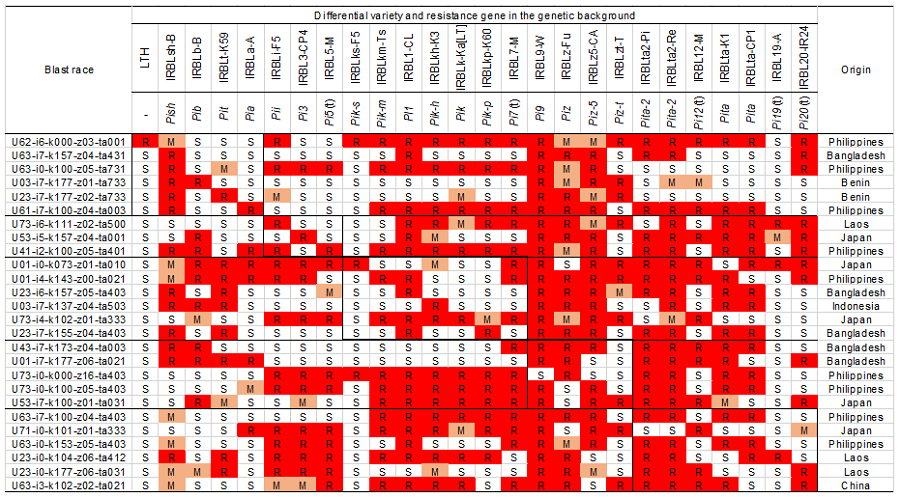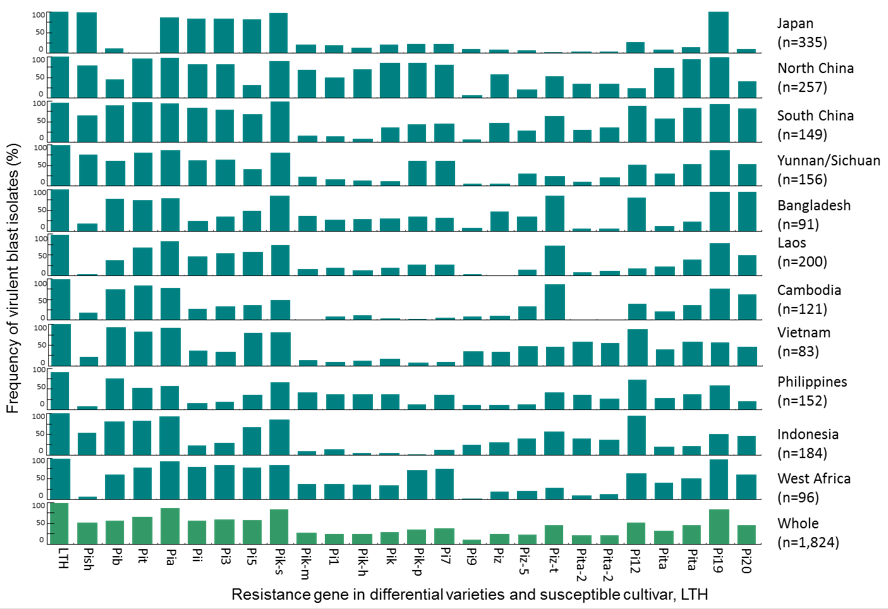Scalable Research Achievement
International differential system to protect against rice blast disease
Description
Blast disease has been found to have caused serious damage to rice production in all areas of the world where rice is cultivated, from tropical to temperate regions. The use of resistance varieties is the most economically and efficient way to protect against rice blast disease in developing countries. The differential system, which can clarify the pathogenicity of blast isolates and resistance in rice cultivars, is a basic and important tool for breeding and pathological works. However, few countries or research institutes have used the differential system and applied the developed technology for crop protection.To establish this protection system against blast disease in developing countries and regions, JIRCAS has conducted international collaborative research for developing and distributing the differential system in Asian and African regions.
Under the international research network, blast isolates and rice germplasm were collected. The pathogenicity of blast isolates using international differential varieties (DVs) and genetic variation of resistance in resistant rice cultivars were clarified. Based on these information, international standard differential blast isolates (ISDBIs) collected from different origins under the research network were selected (Table 1).
The ISDBIs and DVs comprise the international differential system, and the system is being used as the international standard for characterizing the pathogenicity of blast isolates and resistance of rice cultivars. It can also be applied to breeding works in rice cultivars and pathological studies for the development of a protection system.
Participants of the research network including Indonesia, Philippines, Vietnam, Laos, and Bangladesh also selected their respective local standard differential blast isolates, and these domestic differential systems were applied to breeding and pathological studies in each country.
One of the network’s research achievements was the clarification of the wide variations in blast races (Fig. 1). The frequency of blast isolates virulent to DVs was clarified in each country and region and at the global level. The frequency of virulent blast isolates varied among DVs and regions. Particularly, high frequencies of wide-spectrum blast isolate virulence to DVs were found in Bangladesh and West Africa.
Furthermore, the highest diversities of blast races were found from Yunnan province, China, to Bangladesh. The diversities of blast races were corresponded with the those of resistance in rice cultivars. The relationships between blast races and rice varieties are explained by the gene-for-gene theory. The differential system will make it possible to characterize previous resistance genes and to find new genes, such as partial resistance genes, and provide access to the development of application methods for them in rice breeding. The information, i.e., the differential system and these new approaches, will contribute to the development of a durable protection system and for harmonizing agriculture with environment.
Figure, table
-
Table 1. International differential system for rice blast disease
The international differential system consists of 25 differential varieties and the susceptible variety LTH, and 53 international standard blast isolates (Several blast isolates were omitted in the table). Blast race names were designated to each blast isolate selected according to the method of Hayashi and Fukuta (2009). Reactions: S: virulent (susceptible), M: moderate, R: Avirulent (resistant)
-
Fig. 1. Frequency of virulent blast isolates to differential variety in each country and region
Wide variations in virulent blast isolates to each differential variety were found, and they varied among regions. Wide-spectrum blast isolates virulent to differential varieties were found in Bangladesh and West Africa at high frequencies.
- Affiliation
-
Japan International Research Center for Agricultural Sciences Tropical Agriculture Research Front
- Classification
-
Research
- Research project
- Program name
- Term of research
-
FY2020(FY2016~FY2020)
- Responsible researcher
-
Fukuta Yoshimichi ( Tropical Agriculture Research Front )
SAITO Hiroki ( Tropical Agriculture Research Front )
Obara Mitsuhiro ( Biological Resources and Post-harvest Division )
Yanagihara Seiji ( Biological Resources and Post-harvest Division )
MIERUKA ID: 001780Hayashi Nagao ( Institute of Agrobiological Sciences, NARO )
KAKEN Researcher No.: 90391557 - ほか
- Publication, etc.
-
Kawasaki-Tanaka et al. (2016) Plant Dis., 100:816-823https://doi.org/10.1094/PDIS-04-15-0442-REKhan et al. (2016) Plant Dis., 100:2025-2033https://doi.org/10.1094/PDIS-12-15-1486-REKhan et al. (2017) Breed. Sci., 67:493-499https://doi.org/10.1270/jsbbs.17039Odjo et al. (2017) Breed. Sci., 67:500-508https://doi.org/10.1270/jsbbs.17051Fukuta et al. (2019) Plant Dis., 103:3181-3188https://doi.org/10.1094/PDIS-04-19-0870-REFukuta et al. (2019) Breed. Sci., 69:672-679https://doi.org/10.1270/jsbbs.19065Nguyen et al. (2020) Plant Dis. 104:381-387https://doi.org/10.1094/PDIS-05-19-1008-REXangsayasane et al. (2020) Plant Health Prog., 21:248-255https://doi.org/10.1094/PHP-05-20-0041-RSOrn et al. (2020) Breeding Sciencehttps://doi.org/10.1270/jsbbs.20052Santoso et al. Plant Dis. 105:675-683https://doi.org/10.1094/PDIS-05-20-0949-RE
- Japanese PDF
-
2020_B11_A4_ja.pdf444.1 KB
2020_B11_A3_ja.pdf524.71 KB
- English PDF
-
2020_B11_A4_en.pdf381.92 KB
2020_B11_A3_en.pdf384.18 KB
- Poster PDF
-
2020_B11_poster.pdf713.33 KB
* Affiliation at the time of implementation of the study.


